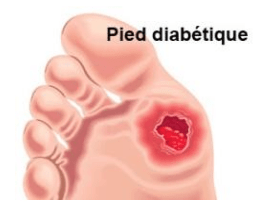The diabetic foot
Diabetes mellitus is a disease where the pancreas does not produce or little insulin, which leads to elevated levels of blood sugar.
Development of diabetes related complications:
The elevation but also the fluctuation in blood sugar in the blood damages various organs, especially the nerves. Small nerves in the feet and hands sometimes lose their ability to feel pain, temperature, vibration, etc… This loss of sensation leaves people unaware of their injuries. Loss of sensation is called neuropathy. Small blood vessels are also affected, which reduces the ability of wound healing.
 Symptoms:
Symptoms:
Foot injuries often progress into sores that can become infected. Wound infection is the leading cause of amputation in Quebec. Prevention can reduce up to 85% of cases of amputation.
Prevention:
- Watch your feet daily for redness, swelling, blisters or cuts. Take a mirror if necessary. Immediately put an antibiotic cream and a bandage if there is an injury and call your podiatrist. LEAVE A MESSAGE OF RECALL IF URGENT
- NEVER walk barefoot.
- Always dry your feet even between the toes out of the shower. Put a moisturizer on your feet (except between the toes) every day to keep the skin supple.
- Check your feet by a specialist every year if there is no nerve damage, or 3 months if neuropathy is present.
- Remove corns and callus periodically to ensure that there is no wound underneath and to cut the nails if they are likely to get ingrown.
- Wear orthotics plantar device to restore pressure points if the foot is at risk.
References: www.diabete.qc.ca or www.diabete.ca